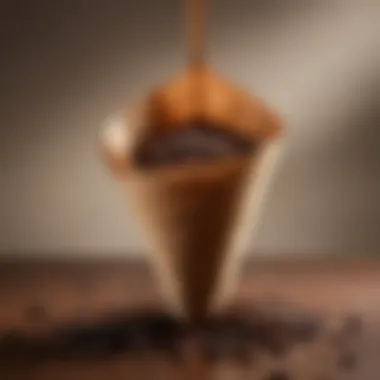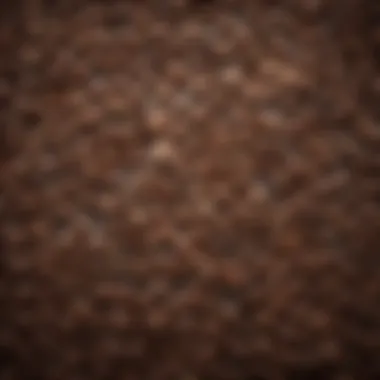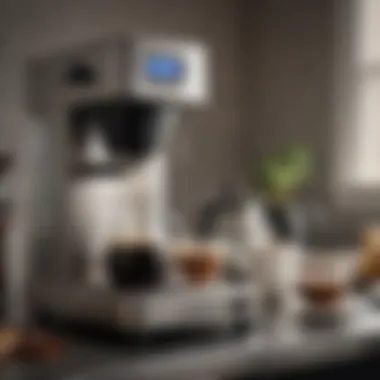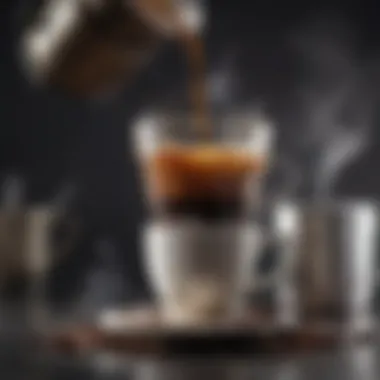Mastering Single Cup Drip Coffee: A Complete Guide


Intro
Brewing coffee has become an essential routine in many people's daily lives. In our fast-paced world, the pursuit of quality coffee involves not just convenience but also a level of craftsmanship. This guide takes a closer look at single cup drip coffee cones. These tools allow for simplicity while preserving the profound flavors that coffee can offer. Here, we will analyze the devices for brewing, explore the ideal techniques, and scrutinize different types of coffee that enhance the experience.
Understanding the working mechanism of single cup drip cones is critical. A meticulous selection of equipment, alongside skillful execution, ensures a satisfying outcome. Yet, there are pitfalls that many novice brewers encounter. Awareness of these potential issues can vastly improve the quality of your brew.
This examination aims to elevate your knowledge about coffee brewing to allow for a rewarding journey into the world of single cup drip coffee. Whether a adept brewmaster or a budding enthusiast, this guide will provide you the tools you need to perfect your craft.
Recipe Overview
To kick things off, let's provide some baseline information about the technique you'll engage in with single cup drip coffee cones:
- Creative Name: Drip Perfection – A Coffee Connoisseur’s Delight
- Portions: 1 cup (approximately 8 ounces)
- Time Required: 5-10 minutes prep and brew time
- Difficulty Level: Easy
- Main Ingredients:
- Freshly ground coffee
- Filter paper or metal filter
- Hot water (ideally around 200 degrees Fahrenheit)
- Coffee maker/cone
Step-by-Step Instructions
To start brewing, you will need certain steps to ensure quality. Here are detailed instructions for successfully using single cup drip coffee cones:
- Prep Ingredients: Use quality freshly ground coffee. A general guideline is about 2 tablespoons per 6 ounces of water. Use your preferred grind degree, but usually, medium grind suffices for proper steeping.
- Select Coffee Cone: Feature a stable surface for the cone. Place a coffee filter inside the cone. If using a metal filter, rinse it with hot water to pre-warm it and remove any residual flavors.
- Boil Water: Utilizing a kettle, heat water while ensuring not to hit full boil. The optimal temperature for brewing is about 200 degrees Fahrenheit, just below boiling.
- Coffee Placement: Add coffee grounds into the filter. Spread it carefully into an even layer, ensuring uniform extraction during brewing.
- Add Water: Slowly pour hot water over the coffee grounds while ensuring that all ground are saturated. Do it in a circular motion for more even extraction. Avoid disturbing the coffee bed too much.
- Drip and Wait: Let the water completely pass through the grounds into your cup or carafe below. Wait until all liquid drips down before discarding the filter or composting the grounds.
- Taste and Adjust: Enjoy your coffee. Adjust the coffee-to-water ratios or grind size based on your taste preference for next time.
Important: Monitor your water temperature closely. Too hot can result in bitter flavors, while water that's not hot enough may taste underextracted.
Nutritional Information
While drinking just coffee may appear insignificant, here is a simplified breakdown concerning beneficial aspects:
- Calories (per cup): ~ 2 calories (without additives)
- Macro Breakdown:
- Proteins: Negligible
- Fats: Negligible
- Carbohydrates: Negligible
Highlights of nutrients found in coffee include antioxidants and important nutrients such as Vitamins B2 and B3, as well as magnesium. Encourage thinking of coffee not only for its caffeine but also for its potential health benefits, balancing consumption within a healthy lifestyle.
Quick Brewing Tips
Consider these methods not just to simplify your brewing process but to also enhance its effectiveness:
- Gadgets: Leverage devices like a gooseneck kettle for precise pouring or a burr grinder for more uniform grounds.
- Multitasking: Prepare breakfast while the water brews or explore news articles during the drip time to optimize your mornings.
- Alternatives: If short on coffee, consider using a blend of coffee substitutes but be mindful of water filtration no matter what method you try.
Related Techniques & Variants
Linked to single cup drip cones, readers may find interest in these popular methods or creative adjustments. While it is important to understand single cup techniques, consider exploring:
- Pour-over techniques such as Chemex
- French press for more robust flavors
- Espresso shots for a concentrated brew
Taste is subjective. Adapt your recipes by adding milk, cream, or different spice like cinnamon for unique variations that tailor to specific diets or palate preferences. Non-dairy alternatives are often flavorful switching options that should be explored.
Encourage sharing innovative practices and newly discovered flavors with like-minded enthusiasts. Simplify what coffee means to you and how it can be ingeniously woven into daily routine. If you'd like to discuss or query coffee tips, subreddit like r/Coffee can offer insight and community support.
Prologue to Drip Coffee Cones
Drip coffee cones have become central to the modern coffee brewing experience. In an era where time is of the essence, the ability to brew an excellent cup quickly and efficiently is a significant benefit. Single cup drip coffee cones allow enthusiasts to customize their coffee while ensuring each brew maintains consistency and quality.
Definition and Functionality
A drip coffee cone is a simple device designed to facilitate the brewing of coffee by allowing hot water to pass through coffee grounds. The primary components include a cone-shaped filter holder and a filter, either paper or metal. Hot water is poured onto the grounds in the cone, allowing the brewed coffee to collect below into a mug or carafe.
This structure serves both functional and aesthetic purposes. The shape promotes a specific flow of water over the coffee grounds, enabling effective extraction of flavors. A cone’s pointed bottom allows water to flow through at a controlled rate, and factors such as the grind size and coffee amount significantly affect the extraction process.


Effective use of a drip coffee cone can yield delightful taste profiles, highlighting the nuances present in various coffee beans while allowing the drinker to fully appreciate the moment of brewing.
Evolution of Coffee Brewing Techniques
The history of coffee brewing is long and complex, stretching back centuries, where brewing methods continually evolved. It began with simple immersion methods before paving the way to innovative techniques involving extracts and filter brews.
As coffee culture expanded, consumers began seeking convenience and variety over single, communal pots. The advent of the drip coffee cone marked a point of historical significance, embracing the trend toward individual coffee experiences. It cleverly upgrades older methods by combining simple design with modern convenience, addressing the diverse preferences of today's coffee drinkers. Various devices have emerged since, including pour-over systems and single-serve machines, highlighting a shift toward quality and customization.
Understanding Single Cup Drip Brewing
Understanding single cup drip brewing is foundational to elevating your coffee experience. This method caters to the contemporary need for convenience while maximizing flavor. Drip brewing focuses on individual servings, ensuring each cup is fresh, aromatic, and tailor-made according to one’s preference.
The Mechanics Behind Drip Brewing
Drip brewing involves a simple but effective process. Hot water transitions through grounds, extracting essential oils and flavor compounds. This function is orchestrated by a mechanism that allows controlled water flow. The water temperature, contact time with coffee, and grind size are parameters that influence the resulting brew.
- Water Temperature: Optimal temperatures typically range between 195°F and 205°F. If water is too cold, under-extraction occurs. Overly hot water may result in bitter flavors.
- Grind Size: A medium grind offers balanced extraction. Too coarse may lead to watery coffee, while too fine a grind can produce bitterness.
- Brewing Time: The general brewing time should be about 4 to 6 minutes for best results.
With each step, precision is key. These mechanics manifest how the drip coffee cone functions to create a coveted cup.
Benefits of Single Cup Brewing
Single cup brewing offers various advantages, especially appealing to discerning coffee drinkers. The following points outline key benefits:
- Freshness: As beans are ground immediately before use, it retains volatile oils.
- Flexibility: Tailoring the brew strength as per mood becomes possible, reducing uniformity seen in larger brewing methods.
- Less Waste: Only brew what is needed. If one cup is desired, waste is minimized, which is eco-friendly and efficient.
- Convenient Cleanup: Equipment is simpler, leading to easier maintenance.
These factors construct a sound argument for preferring single cup drip brewing over other methods. Each step serves to celebrate the art of making coffee, fostering a more personalized interaction with each cup brewed.
The key to mastering single cup drip brewing lies in understanding the intricate interactions of time, temperature, and grind.
Choosing the Right Drip Coffee Cone
In the quest for the perfect cup of coffee, the choice of the right drip coffee cone plays a pivotal role. This selection influences not only the flavor of the coffee but also affects the brewing experience. It is essential to understand the various elements that come into play when selecting a cone that will best suit personal preferences and needs. \nThe material, size, and overall design of the coffee cone are critical factors that can significantly enhance one’s brewing method.
Material Considerations: Plastic vs.
Metal vs. Ceramic
When it comes to drip coffee cones, materials vary widely. One must appreciate how each material impacts the coffee flavor and brewing process.
- Plastic: Commonly used due to its affordability and lightweight nature. This material is accessible and versatile, suiting individuals who seek a simple brewing solution. However, plastic cones may not retain heat as effectively, which could affect extraction rates. Smell absorption is also a concern, impacting flavor over time.
- Metal: Metal cones, like those made of stainless steel, tend to have better durability and heat retention. They allow for even extraction, but they might require regular maintenance to prevent rust or stains. Some also prefer the aesthetic appeal of metal, which often aligns with modern kitchen designs.
- Ceramic: This material offers a balance of heat retention and aesthetic appeal, commonly known for its unique designs. Ceramic cones are favored for their ability to maintain consistent temperatures. Yet, their fragility is a point to consider, requiring more careful handling during use and washing.
Selecting the right material ultimately comes down to personal taste and brewing method preferences. A curious mind should explore the pros and cons before committing to one option over another.
Sizing: Matching Cone to Cup
Proper sizing of the drip coffee cone is crucial for an optimal brewing experience. The fit between the cone and the cup dictates how well the coffee extracts and how fast the brewing process occurs.
To achieve a perfect match:
- Cup Size: Identify the size of the cup you typically use. A smaller cone for espresso-sized cups delivers more concentrated flavors, while larger cones accommodate a regular coffee cup or a thermal carafe.
- Water to Coffee Ratio: Sizing impacts the available surface area for water interaction with coffee grounds. Those seeking strong brews may favor cones sized precisely for their measurements, while others could benefit from larger ones that promote slow extraction.
- Cone Design: A wide opening may allow for fast drainage, affecting brew strength. In contrast, a funnel-shaped cone might produce a slower brew but deepen flavor complexity.
Aligning size considerations with usage will lead to a more satisfying overall experience.
Choosing the right drip coffee cone setting the foundation for a refined coffee ritual. Numerous variables will either amplify or inhibit the complex flavors locked within each bean.
Selecting Coffee Beans
Selecting coffee beans is a critical step in creating an exceptional cup of drip coffee. The quality and type of beans you choose have profound effects on flavor, aroma, and overall experience. Different beans carry distinct flavor profiles, growing conditions, and processing methods that influence the final product. Emphasizing this step is essential to ensure you obtain a cup that reflects your personal preferences and satisfies your discernment.
Coffee Types: Arabica vs.


Robusta
When it comes to coffee, the two dominant species are Arabica and Robusta. Each type offers unique qualities and flavors, making them suitable for varied tastes.
- Arabica: Generally considered superior in quality, Arabica beans have a smooth, complex flavor profile. They usually have a higher acidity and a better aroma than other types, often showcasing delightful notes of fruit, sugar, and floral essences. Arabica grows at higher elevations, requiring specific climatic conditions and more care during cultivation. This care tends to reflect a broader spectrum of flavors.
- Robusta: These beans are easier to grow, are more resilient to pests, and can flourish at lower altitudes. Robusta coffee is known for its strong, often earthy taste and greater caffeine content compared to Arabica. Many espresso blends incorporate Robusta to add body and enhance crema. However, it is seen as less refined, with a tendency for bitterness not present in Arabica. Understanding these differences allows you to tailor your choice based on preferred attributes.
Roast Levels and Their Impact on Flavor
The roast level of coffee beans can drastically alter their flavor characters. Choosing the right roast can enhance your brewing process, contributing to a cup tailored to your liking. Here are the common roast levels:
- Light Roast
- Typically retains most of the beans' original flavor.
- Vibrant acidity and bright flavors shine through with delicate notes.
- Less prevalent body or weight.
- Medium Roast
- Balances acidity with a fuller body and a sweeter flavor profile.
- The complexity comes from natural flavors combined with the toasty notes of roasting.
- Dark Roast
- Characterized by bold, robust flavors with less acidity.
- The roasting process often introduces smoky or bitter notes, sometimes overpowering the base flavor.
"The roast level is as important as the bean type itself, drastically shaping the sensory outcome of the final brew."
Knowing the different roast levels enables more precise choices, aligning the coffee's essence with your preferred brewing techniques. Understanding these specifics influences the coffee's aroma and wraps each cup in personal preference and quality.
In summary, selecting the right coffee beans is foundational. Arabica's elegance and Robusta's robustness can meet varied palates, while roast variations play a fundamental role in defining the experience. Targeting these details can lead to a profoundly rewarding tea or coffee ritual, elevating the seemingly simple task of brewing into a remarkable daily experience.
Grinding Your Coffee
The significance of grinding your coffee cannot be underestimated in the art of brewing. It plays a critical role in determining the flavor and quality of each cup. The grind size affects the extraction process and influences the overall taste of the coffee. Therefore, understanding the nuances of how coffee is ground is essential.
Freshly ground coffee retains essential oils and flavors better than pre-ground options. Once coffee beans are ground, they start to lose their freshness rapidly due to oxidation. Hence, grinding should ideally occur just before brewing. This practice maximizes the aromatic experience while ensuring optimal flavor extraction.
Grind Size and Its Importance
Grind size refers to the fineness or coarseness of the coffee grounds. The size of the coffee grind influences how water interacts with the coffee during brewing. Different brewing methods call for specific grind sizes.
- A finer grind increases surface area, which can lead to quicker extraction. This is advantageous for methods such as espresso but may result in over-extraction for drip coffee.
- Conversely, a coarser grind slows down extraction, ideal for French press or cold brew.
Using the wrong grind size can produce undesirable flavors. For drip coffee, a medium grind is often recommended. It permits balanced extraction, neither too fast nor too slow. Understanding this helps the enthusiast optimize their cup.
Grinding Methods: Manual vs.
Electric
When choosing a method for grinding coffee, two main options present themselves: manual and electric grinders. Each comes with its advantages and disadvantages, depending on user preferences and brewing needs.
Manual grinders offer precision. They grant more control over grind size since the user can easily adjust the technique during grinding. Users tend to enjoy the process and appreciate a more engaged brewing experience. However, using a manual grinder can be time-consuming and labor-intensive, especially when larger quantities are needed.
On the other hand, electric grinders provide convenience and speed. Most allow for consistent grind sizes, suitable for various brewing methods. Some models include settings tailored specifically for drip coffee, ensuring proper distribution. A downside is the potential for inconsistency in grind size if the grinder doesn’t offer precise settings.
It's essential to choose a grinder that fits your brewing style and consumption habits.
Ultimately, the choice between manual and electric comes down to personal preference and brewing requirements. Both methods can yield great results if used correctly.
Brewing Techniques for Optimal Flavor
Understanding brewing techniques can make a significant difference in the quality of your coffee. This section highlights the essential aspects that contribute to achieving optimal flavors through various brewing methods. Knowledge of these elements empowers coffee enthusiasts to not just make a beverage but to craft an experience. When each parameter is fine-tuned, one can reveal and enhance the subtleties in the characteristics of the chosen coffee beans.
Water Temperature and Its Role


Water temperature is among the most vital factors in the brewing process. The general consensus is that between 195°F and 205°F (90°C to 96°C) serves as the sweet spot for optimal extraction. Water too hot can lead to over-extraction, which may result in a bitter taste. Conversely, water that is too cold will under-extract, leading to a lack of flavor development.
To illustrate, when brewing with a water kettle, allowing it to reach boiling point and then off the heat for 30 seconds can target this ideal range. Experimenting with adjustments within this range can unlock the full potential of the coffee's flavor profile.
Key insight: Always use a thermometer if precision is crucial. A temperature that strikes the balance can indeed be the thin line between a pleasant sip and a regrettable taste.
Brewing Time: Finding the Right Balance
Brewing time is equally significant. The extraction process varies depending not only on the temperature but also on time. Typically, a single cup drip brewing might occur between 2.5 to 4 minutes, but this can be modified to cater to personal taste. Shorter brewing times yield a lighter body and brighter acidity, while longer durations may enhance fullness but increase bitterness.
To find readiness, one may observe color saturation and aroma. For instance, if the coffee appears fully dark yet does not feel heavy on the palate, it likely needs more time. Same goes for the scent – when the coffee scent becomes robust yet pleasant, that core extraction phase has likely been achieved.
In the context of all this, maintaining the balance between water temperature and brewing time will result in exquisite and rich flavors that create an enjoyable beverage experience.
Utilizing precise measurements and timing can eliminate the frustration surrounding brewing processes. Therefore, commit time observing and refining these techniques, as they are crucial for aspiring culinary enthusiasts seeking that perfect cup.
Common Mistakes and How to Avoid Them
Understanding common mistakes in the process of drip coffee brewing is vital for any enthusiast looking to elevate their morning ritual. While it may seem straightforward, several factors contribute to a poor cup of coffee. By identifying these potential pitfalls, you can refine your technique and enhance overall flavor. This section addresses two key issues: over-extraction and under-extraction, as well as incorrect coffee-to-water ratios. Awareness of these mistakes can significantly improve your brewing experience.
Over-Extraction and Under-Extraction
Over-extraction occurs when hot water extracts too many compounds from the coffee grounds. This can lead to a bitter, unpleasant taste. Factors contributing to this issue include using overly fine coffee grounds or allowing water to flow through the coffee for too long. High temperatures can exacerbate the problem, pulling out unwanted flavors that mask the more pleasant notes of the coffee.
To avoid over-extraction:
- Use the right grind size: A medium-coarse grind typically works well for drip brewing.
- Monitor water temperature: Ideal temperatures are between 195°F (91°C) and 205°F (96°C).
- Time your brew: Most drip coffee should be finished brewing in about four to five minutes.
Conversely, under-extraction happens when not enough flavor compounds are extracted, resulting in a weak and sour cup. This can occur from using too coarse of a grind or insufficient brewing time.
To prevent under-extraction:
- Check grind size: Ensure the grind is not too coarse for your method.
- Extend brew time: A brewing time of around 3 to 4 minutes may help achieve the right extraction balance.
- Adjust water temperature: Lower temperatures can lead to under-extraction; hence, aim for the ideal range mentioned earlier.
Achieving the right balance in extraction is essential for a satisfying cup of coffee.
Incorrect Coffee-to-Water Ratios
An essential element in coffee brewing is the coffee-to-water ratio. An improper ratio can ruin even the best coffee. Too much coffee relative to water results in a overpowering cup, which may be unpalatable. Conversely, too little coffee can lead to weak, lifeless brews.
The recommended coffee-to-water ratio for drip coffee typically revolves around 1:15 to 1:18. For example:
- For a strength of 1:15, use 20 grams of coffee for 300 ml of water.
- For a lighter coffee at 1:18, use 15 grams for the same volume of water.
Tips for getting right ratios include:
- Use a scale: Weigh your coffee and water for precise measurement.
- Start with a standard ratio: Experiment within the recommended range until you find your preferred strength.
- Adjust gradually: If the coffee is too strong or weak, slightly change the quantity of coffee or water, instead of making drastic adjustments.
Proper management of extraction and water ratios will enhance your coffee preparation and allow your espresso to bloom with distinct flavors.
The End
In this article, we explored the multifaceted nature of single cup drip coffee cones. Their design allows for personalization in brewing, making them suitable for individual preferences. The importance of understanding key aspects of this brewing method can not be overstated; it affects both the quality and enjoyment of your coffee.
Summarizing Key Takeaways
While we journeyed through the essentials, several key takeaways stand out:
- Techniques Matter: Mastering water temperature and brewing time can significantly improve flavor.
- Perfect Pairing: Choosing the right coffee beans, grind size, and brewing cone ensures an elevated cup.
- Attune Your Process: Avoiding common mistakes around extraction and coffee-to-water ratios helps in achieving consistent results.
These elements present a landscape where coffee brewing moves beyond a mere routine into a cherished activity. With attention to detail, one can craft not just coffee, but an experience.
Encouraging the Pursuit of Quality Coffee
To all the culinary enthusiasts, the pursuit of quality coffee is a journey worthy of time and effort. Investing in the right equipment and taking the necessary time in each brewing step leads to delicious dividends. This commitment creates not only richer taste but also enhances appreciation of coffee as an art form.
Consider deeper exploration: from trying various beans to experimenting with different copper and ceramic cones. Dive into the nuances of your preferred brewing style and learn more along the way. You may find joy in the process and savor a cup that encapsulates your individual taste. Find welcoming communities and clever resources—each becomes part of your journey towards quality coffee.







